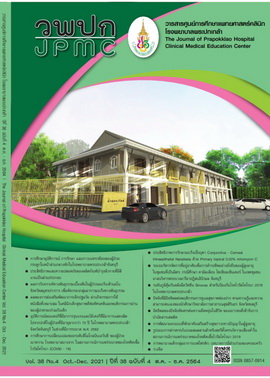การศึกษาการเปลี่ยนแปลงของระดับฮีโมโกลบินเอวันซี ของผู้ป่วยเบาหวาน โรงพยาบาลบางจาก ในสถานการณ์การแพร่ระบาดของโรคติดเชื้อไวรัสโคโรนา (COVID - 19)
Main Article Content
บทคัดย่อ
ที่มาของปัญหา: ในสถานการณ์การแพร่ระบาดของโรคติดเชื้อไวรัสโคโรนา (COVID - 19) ซึ่งส่งผลกระทบต่อการใช้ชีวิตประจำวันของผู้ป่วยเบาหวานที่เปลี่ยนแปลงไป มีผลกระทบอย่างไรต่อการควบคุมระดับฮีโมโกลบินเอวันซี (HbA1c) ของผู้ป่วย
วัตถุประสงค์: เพื่อศึกษาการเปลี่ยนแปลงของระดับฮีโมโกลบินเอวันซี ในผู้ป่วยเบาหวานในช่วงที่มีการแพร่ระบาดของโรคติดเชื้อไวรัสโคโรนา (COVID - 19)
วิธีการศึกษา: การศึกษานี้เป็นการวิจัยโดยการสังเกตเชิงวิเคราะห์ ณ จุดเวลาใดเวลาหนึ่ง (cross - sectional analytic design) จำนวนประชากรที่ใช้ในการวิจัยทั้งหมด 322 ราย ซึ่งเป็นผู้ป่วยโรคเบาหวานที่ได้รับการเจาะเลือดตรวจระดับฮีโมโกลบินเอวันซีในโรงพยาบาลบางจาก ตั้งแต่วันที่ 1 เดือนพฤษภาคม พ.ศ. 2563 ถึงวันที่ 30 เดือนมิถุนายน พ.ศ. 2563 โดยนำมาเปรียบเทียบกับระดับฮีโมโกลบินเอวันซีที่เคยได้รับการตรวจมาก่อนหน้า ในระยะเวลาไม่เกิน 1 ปี
ผลการศึกษา: จากผู้ป่วยเบาหวานทั้งหมดจำนวน 322 ราย เป็นเพศหญิงร้อยละ 59.9 มีอายุเฉลี่ย 63.3 (SD = 11.8) ปี มีกลุ่มที่มีระดับฮีโมโกลบินเอวันซีลดลงหรือเท่าเดิมจำนวน 200 ราย (ร้อยละ 62.1) และมีกลุ่มที่ระดับฮีโมโกลบินเอวันซีเพิ่มขึ้นจำนวน 122 ราย (ร้อยละ 37.9) โดยกลุ่มที่มีระดับฮีโมโกลบินเอวันซีเพิ่มขึ้น มีค่าเฉลี่ยของ eGFR ที่สูงกว่า (85.3 ± 20.7, 79.7 ± 23.4, p = 0.03) และระดับไขมัน HDL ที่ต่ำกว่า (46.2 ± 10.7, 50.3 ± 17.0, p = 0.03) กลุ่มที่มีระดับฮีโมโกลบินเอวันซีลดลงหรือเท่าเดิม อย่างมีนัยสำคัญทางสถิติ
สรุป: ผู้ป่วยเบาหวานกลุ่มที่มีระดับฮีโมโกลบินเอวันซีลดลงหรือเท่าเดิมมีสัดส่วนที่มากกว่ากลุ่มที่ระดับฮีโมโกลบินเอวันซีเพิ่มขึ้น และผู้ป่วยกลุ่มที่มีระดับฮีโมโกลบินเอวันซีเพิ่มขึ้นมีค่าเฉลี่ยของ eGFR ที่สูงกว่า และระดับไขมัน HDL ที่ต่ำกว่ากลุ่มที่มีระดับฮีโมโกลบินเอวันซีลดลงหรือเท่าเดิม อย่างมีนัยสำคัญทางสถิติ
Article Details
References
World Health Organization. Coronavirus disease(COVID-19) pandemic [Internet]. 2020 [cited 2020 Sep 2]. Available from: https://www.who.int/emergencies/diseases/novel-coronavirus-2019
World Health Organization. WHO Coronavirus (COVID-19) dashboard [Internet]. 2020 [cited 2020 Sep 2]. Available from: https://covid19.who.int/?adgroupsurvey{adgroupsurvey}&gclid=EAIaIQobChMIrJOdt_Si8gIViXZgCh2dFwTWEAAYASABEgIawfD_BwE
Department of Disease Control. Corona virus disease(COVID-19) [Internet]. 2020 [cited 2020 Sep 2]. Available from: https://ddc.moph.go.th/viralpneumonia/index.php
Hussain S, Baxi H, Jamali MC, Nisar N, Hussain MS. Burden of diabetes mellitus and its impact on COVID-19 patients: A meta-analysis of real-world evidence. Diabetes& Metabolic Syndrome: Clinical Research& Reviews 2020;14:1595-602.
Guo L, Shi Z, Zhang Y, Wang C, Do Vale Moreira NC, Zuo H, et al. Comorbiddiabetes and the risk of disease severity or death among 8807 COVID-19 patientsin China: a meta-analysis. Diabetes Res ClinPract[Internet].2020 [cited 2020 Sep 2];166:108346. Available form: https://www.ncbi.nlm.nih.gov/pmc/articles/PMC7375287/pdf/main.pdf
Pal R, Bhadada SK. COVID-19 and diabetes mellitus: An unholy interaction of two pandemics. Diabetes & Metabolic Syndrome: Clinical Research & Reviews. 2020;14:513-7.
Ciceri F, Castagna A, Rovere-Querini P, De Cobelli F, Ruggeri A, Galli L, et al.Early predictors of clinical outcomes of COVID-19 outbreak in Milan, Italy. ClinImmunol[Internet]. 2020 [cited 2020 Sep 2];217:108509. Available form: https://www.ncbi.nlm.nih.gov/pmc/articles/PMC7289745/pdf/main.pdf
Barron E, Bakhai C, Kar P, Weaver A, Bradley D, Ismail H, et al. Associations of type 1and type 2 diabetes with COVID-19-related mortality in England: a whole-population study. Lancet Diabetes Endocrinol 2020;8:813-22.
Sacks LJ, Pham CT, Fleming N, Neoh SL, Ekinci EI. Considerations for peoplewith diabetes during the Coronavirus disease (COVID-19) pandemic. Diabetes ResClinPract [Internet]. 2020 [cited 2020 Oct 10];166:108296.Available form: https://www.ncbi.nlm.nih.gov/pmc/articles/PMC7332442/pdf/main.pdf
Abdi A, Jalilian M, Sarbarzeh PA, Vlaisavljevic Z. Diabetes and COVID-19: asystematic review on the current evidences. Diabetes Res ClinPract [Internet]. 2020 [cited 2020 Oct 10];166: 108347.Available form: https://www.ncbi.nlm.nih.gov/pmc/articles/PMC7375314/pdf/main.pdf
Singh AK, Khunti K. Assessment of risk, severity, mortality, glycemic control and antidiabetic agents in patients with diabetes and COVID-19: A narrative review. Diabetes Res ClinPract [Internet]. 2020 [2020 Sep 12];165:108266.Available form: https://www.ncbi.nlm.nih.gov/pmc/articles/PMC7286824/pdf/main.pdf
Alshareef R, Al Zahrani A, Alzahrani A, Ghandoura L. Impact of the COVID-19 lockdown on diabetes patients in Jeddah, Saudi Arabia. Diabetes & Metabolic Syndrome: Clinical Research & Reviews. 2020;14:1583-7.
Nachimuthu S, Vijayalakshmi R, Sudha M, Viswanathan V. Coping with diabetes during the COVID–19 lockdown in India: results of an online pilot survey. Diabetes & Metabolic Syndrome: Clinical Research & Reviews 2020;14:579-82.
BMA Data Center. Announcement of the Bangkok Metropolitan Administration (BMA), subject: order of temporary closure of premises (No. 2) [Internet]. 2020 [cited 2020 Sep 2]. Available from: http://www.prbangkok.com/th/post/view/MDY1cDBzNnM0NHIyb3Ezc3E2NnEyNDk0cDRyOTQzcjQ3MjY1MQ
BMA Data Center. Announcement of the Bangkok Metropolitant Administration (BMA), subject: order of temporary closure of premises (No. 12) [Internet]. 2020 [cited 2020 Sep 2]. Available from: http://www.prbangkok.com/th/post/view/MDY1cDBzNnM0NHIyb3Ezc3E2NnEyNDk0cDRyOTQzcjQ5MDQ4MQ
Kosachunhanun N, Benjasuratwong Y, Mongkolsomlit S, Rawdaree P, PlengvidhyaN, Leelawatana R, et al.Thailand diabetesregistry project: glycemic control in Thai type 2 diabetes and its relation tohypoglycemic agent usage. J Med Assoc Thai 2006;89 (Suppl 1):S66-71.
Gatti A, Maranghi M, Bacci S, Carallo C, Gnasso A, Mandosi E, et al. Poor glycemic control is an independent riskfactor for low HDL cholesterol in patients with type 2 diabetes. Diabetes Care 2009;32:1550-2.
